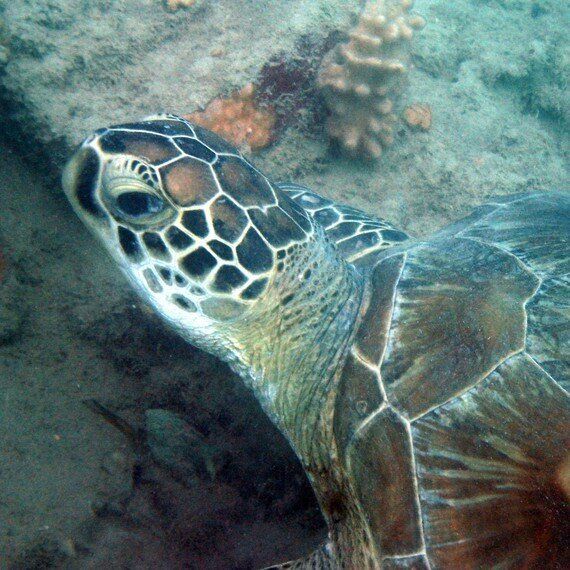Bianca Young talks about her time on the Madagascar Marine Conservation & Diving project. Bianca discusses her love for turtles and goes into great detail about how turtles are threatened on a daily basis from poachers and sea pollution. If you love turtles, then look no further.

Image courtesy of Frontier's Madagascar Marine Conservation & Diving project.
The waters along the coast of Madagascar host five of the seven species of sea turtles: Green Turtles, Hawksbill Turtles, Loggerhead Turtles, Leatherback Turtles and Olive Ridley Turtles. In the northern region of the country, Green and Hawksbill are relatively common since a lower population density essentially reduces the threat to turtle nesting areas. I say relatively common, however, sadly all seven marine turtles are now endangered, some to greater degrees than others.
A native Jamaican, a country whose waters have been exploited for turtles, in particular Green and Hawksbill Turtles, since the 1600s, I arrived in Nosy Be hopeful and excited to sea more of the magnificent creatures. My first few days on camp in Ambalahonko were nothing less than thrilling, with the highlight being a humpback whale sighting on my first day out on the water. But I was still craving a turtle sighting. Everyone told me to stay patient, that in no time at all I would see one if not more, and they were right. Firstly, there was the sighting from the boat at Lokobe and eventually there was the most amazing turtle encounter I have ever had. It happened at one of our dive sites off the island of Nosy Komba, appropriately named Turtle Towers, and I literally almost swam into a beautiful Hawksbill Turtle while reeling out a transect. Had it not been for dive officer Joelle signaling to me, I may have startled it and missed it completely. However, I turned and looked up and less than one meter from me, the turtle hovered, watching me as we crossed paths. I reached for my camera, which promptly died, so I watched mesmerised during the long minute that it passed me. Our eyes were locked and it clumsily bumped the coral below its front right flipper before it swam off.
The beautiful Hawksbill seemed weary but unafraid while we met, and that pleased me the most, especially considering all the threats that turtles experience. First and foremost are the anthropogenic threats. Humans have been killing sea turtles for centuries for their meat, shells, and eggs; the relatively defenseless creatures are an easy catch. On top of that, the exploitation of the world's beaches have endangered and severely decreased nesting areas for turtles. Where nesting sites still exist, newly hatched turtles are subject to disorientation due to coastal lights, which draw them inland rather than into the water. Sea turtle feeding areas have also diminished, often in the name of having sea-grass/seaweed free zones for tourists who also enjoy turtle souvenirs that they can display in their homes. The human threat does not end there. Turtles can drown in fishing nets and can be hit by boats. Pollution of the world's waters can also cause turtle deaths; turtles that feed on jellyfish can mistakenly eat plastic bags, causing then to suffocate. It has also been speculated that the tumor causing disease seen in Loggerhead turtles is a consequence of toxins in the ocean.
Unsurprisingly, turtles are predated on by a variety of animals in the ocean where they spend most of their time, and on land where they lay their eggs; sharks and fish eat turtles, especially juveniles, and crabs, birds, and some land mammals eat turtle eggs and new hatchlings on land. A combination of the abovementioned threats is a sure recipe for sea turtle extinction though worldwide efforts are being made to aid the recovery of turtle populations.
These efforts include but are not limited to protection of nesting areas and juvenile or young individuals through, for example, legislation. Madagascar has existing legislation for the protection of turtles. There are protected areas along the coast of the entire country, including Nosy Be, for Green and Hawksbill Turtles. There are also turtle catch restrictions, which declare that individuals that are laying and/or have a carapace width less than 0.5m must not be caught. However, as is true elsewhere in the world, the enforcement of these marine laws is low and turtles continue to be fished illegally. In Madagascar the species that is normally targeted is the Hawksbill Turtle whose shell is thought of as one of the most beautiful and which can be found stuffed and on sale in many tourist shops.
More work has to be done to protect sea turtles whose long lives, extensive migration, and population dynamics are somewhat of a mystery to us. There is hope globally for all species and in Madagascar, increased awareness, and the development of eco-tourism, marine protected areas, and better law enforcement could have a significant impact on the five species found here.
For me, simply seeing these animals underwater is to understand their beauty, but they are not just beautiful; they play an important role controlling the distribution of algae along tropical coral reefs. They fascinate me and I hope that one day the world will begin to see them through my eyes. My reef-bumping Hawksbill may not live a full life but (despite the lack of photographic evidence) it will remain in my memory and in written accounts such as this for years to come.
Author Bianca Young volunteered for Frontier, an international non-profit volunteering NGO that runs 320 conservation, community, and adventure projects in 57 countries across the globe, on the Madagascar Marine Conservation & Diving project. You can also read more volunteer stories on Frontier's Gap Year Blog and get the latest project and volunteering news from the Frontier Official Facebook page.